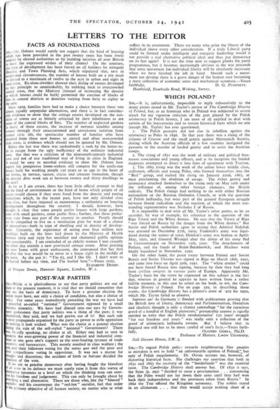LETTERS TO THE EDITOR
FACTS AS FOUNDATIONS
sm,—air. Osborn would surely not suggest that the kind of housing which has been provided in the past twenty years has been freely adopted by elected authorities or by building societies all over Britain to meet the expressed wishes of their clients? On the contrary, this type of development has been forced on all builders by stringent Hosing and Town Planning Acts, which stipulated that, save in exceptional circumstances, the number of houses built on a site Inuit be limited to a maximum of twelve to the acre in urban and eight in rural areas. Ex-slum-dwellers showed their dislike of estates developed on this principle so nnTnistakably, by trekking back to overcrowded central areas, that the Ministry (instead of increasing the density at which houses could be built) permitted the erection of blocks of hats in central districts at densities varying from forty to eighty to the acre.
Since 1919, families have had to make a choice between these two almost equally unpopular alternatives, and there is in fact consider- able evidence to show that the cottage estates developed on the out- arirts of towns are as bitterly criticised by their inhabitants as are many of the central blocks of flats. The number of neglected gardens many of these estates, the increase of nervous troubles among women through their unaccustomed and unwelcome isolation from rmal civic life, the spectacular number of families who have returned from these new homes to central and often overcrowded urn areas, is evidence which should not be ignored by Mr. Osborn. Before the last war there was undoubtedly a rush by the better-to- do to escape from the ugly inefficiency of the ordinary industrial town. But that was a criticism of the nineteenth-century industrial town and not of our traditional way of living in cities in England. It would be easy to marshal evidence to show Mr. Osborn . how eagerly his prosperous home-seekers still compete for the easily-run uses built for working people 15o years or so ago in the heart of towns, in terrace, square, circus and crescent formation, though density does work out at between twenty and thirty dwellings to
e acre!
As far as I am aware, there has been little official attempt to find t the kind of environment or the kind of home which people of all sses would choose if they were freed from the density and zoning trictions which, in the recent past, have not only divided class rom class, but have imposed so monotonous a uniformity on housing evelopment throughout the country. I should, however, have ought it clear that some people prefer houses with large gardens, with small gardens, some prefer flats ; further, that these prefer- es vary from one part of the country to another. People should of be compelled to live on a totalitarian plan for want of a choice f alternatives—both in type of dwelling and in density of develop- ent. Certainly, the experience of seeing over four million new el:1gs built on the lines laid down by the Ministry of Health ween /919 and 1939 has modified and chastened public opinion cry considerably. I am reminded of an elderly woman I met casually e other day outside a new provincial cottage estate. After praising r new home' with great enthusiasm, she announced that her first ct after the war would be to move to a house right in the middle of e town. As she put it: " I'm 63, and I like life. I don't want to buried before my time, and I'm buried here."—Yours truly,


























 Previous page
Previous page